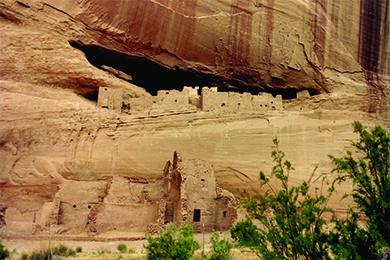| << Chapter < Page | Chapter >> Page > |
In the southwestern part of today’s United States dwelled several groups we collectively call the Pueblo. The Spanish first gave them this name, which means “town” or “village,” because they lived in towns or villages of permanent stone-and-mud buildings with thatched roofs. Like present-day apartment houses, these buildings had multiple stories, each with multiple rooms. The three main groups of the Pueblo people were the Mogollon, Hohokam, and Anasazi.
The Mogollon thrived in the Mimbres Valley (New Mexico) from about 150 BCE to 1450 CE. They developed a distinctive artistic style for painting bowls with finely drawn geometric figures and wildlife, especially birds, in black on a white background. Beginning about 600 CE, the Hohokam built an extensive irrigation system of canals to irrigate the desert and grow fields of corn, beans, and squash. By 1300, their crop yields were supporting the most highly populated settlements in the southwest. The Hohokam decorated pottery with a red-on-buff design and made jewelry of turquoise. In the high desert of New Mexico, the Anasazi, whose name means “ancient enemy” or “ancient ones,” carved homes from steep cliffs accessed by ladders or ropes that could be pulled in at night or in case of enemy attack ( [link] ).

Roads extending some 180 miles connected the Pueblos’ smaller urban centers to each other and to Chaco Canyon, which by 1050 CE had become the administrative, religious, and cultural center of their civilization. A century later, however, probably because of drought, the Pueblo peoples abandoned their cities. Their present-day descendants include the Hopi and Zuni tribes.
The Indian groups who lived in the present-day Ohio River Valley and achieved their cultural apex from the first century CE to 400 CE are collectively known as the Hopewell culture. Their settlements, unlike those of the southwest, were small hamlets. They lived in wattle-and-daub houses (made from woven lattice branches “daubed” with wet mud, clay, or sand and straw) and practiced agriculture, which they supplemented by hunting and fishing. Utilizing waterways, they developed trade routes stretching from Canada to Louisiana, where they exchanged goods with other tribes and negotiated in many different languages. From the coast they received shells; from Canada, copper; and from the Rocky Mountains, obsidian. With these materials they created necklaces, woven mats, and exquisite carvings. What remains of their culture today are huge burial mounds and earthworks. Many of the mounds that were opened by archaeologists contained artworks and other goods that indicate their society was socially stratified.
Perhaps the largest indigenous cultural and population center in North America was located along the Mississippi River near present-day St. Louis. At its height in about 1100 CE, this five-square-mile city, now called Cahokia, was home to more than ten thousand residents; tens of thousands more lived on farms surrounding the urban center. The city also contained one hundred and twenty earthen mounds or pyramids, each dominating a particular neighborhood and on each of which lived a leader who exercised authority over the surrounding area. The largest mound covered fifteen acres. Cahokia was the hub of political and trading activities along the Mississippi River. After 1300 CE, however, this civilization declined—possibly because the area became unable to support the large population.

Notification Switch
Would you like to follow the 'U.s. history' conversation and receive update notifications?